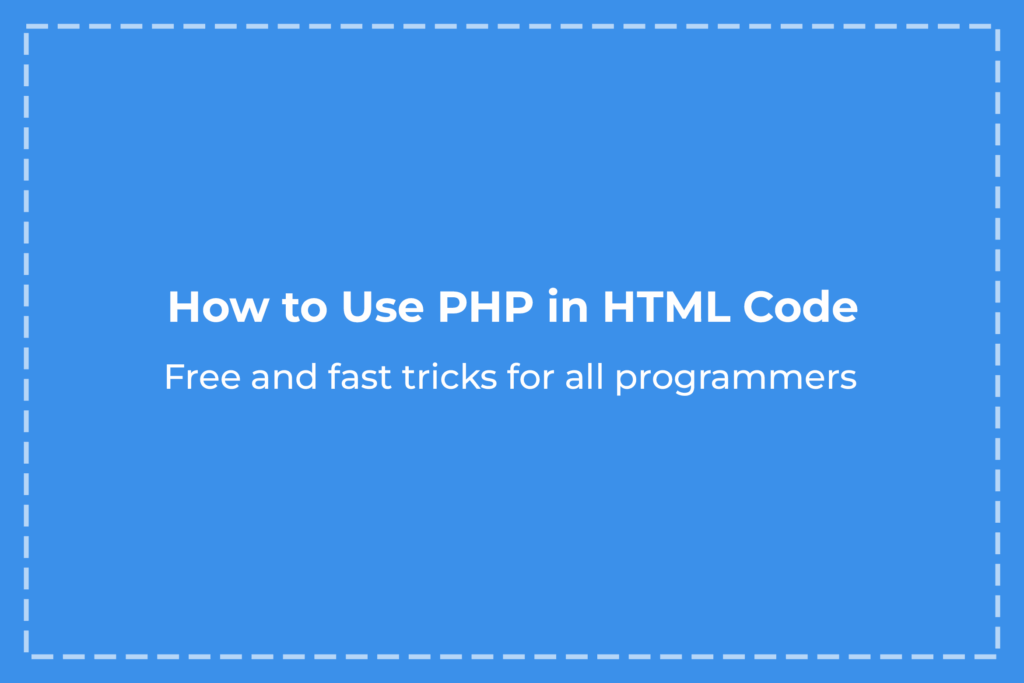In some cases, we need to add simple PHP code on HTML files but we are not professional programmers! So what can we do? In this article, we’ll show you how to use PHP code on your HTML file or pages. In other words, this is a beginner guide to use PHP in HTML Code.
To add PHP code to an HTML file, we need to understand the basics of both HTML and PHP. HTML is a markup language used to create web pages and display content on the browser, while PHP is a server-side scripting language that can process data, interact with databases, and dynamically generate HTML content before it’s sent to the browser. Let’s dive into how you can integrate PHP with HTML, covering best practices, specific techniques, and useful examples.
How to use PHP in HTML Code Step by Step
please note that PHP only performs on servers, the output is built on the server, and the result is sent as HTML to the client browser for rendering. so we need to use a server/host to try these codes.
1. Changing the File Extension
To use PHP in an HTML file, the first step is to change the file extension from .html to .php. For example, if you have a file called index.html, rename it to index.php. This change signals to the server that PHP code within this file should be executed before it sends the HTML output to the client.
2. Embedding PHP Inside HTML
Once the file is recognized as PHP, you can insert PHP code anywhere within the HTML by using PHP tags. The standard syntax for PHP tags is:
<?php
// Your PHP code here
?>
For example, if you want to display a greeting message based on the time of day, you could use this code:
<!DOCTYPE html>
<html lang="en">
<head>
<meta charset="UTF-8">
<meta name="viewport" content="width=device-width, initial-scale=1.0">
<title>PHP in HTML Example</title>
</head>
<body>
<h1>Welcome to My Website</h1>
<p><?php echo "Hello! Today is " . date("l, F j, Y") . "."; ?></p>
</body>
</html>
Output:
![]()
Note: You can use short tag PHP but is not recommended! This example uses PHP shorthand for <?php echo "I Love 52HzPro!";?>:
<?= "I Love 52HzPro!" ?>
How to Use Conditional Statements in PHP
One powerful feature of using PHP within HTML is the ability to use conditional statements to control what content is displayed. Here’s an example of using an if statement to show a different message based on the time of day:
<!DOCTYPE html>
<html lang="en">
<head>
<meta charset="UTF-8">
<meta name="viewport" content="width=device-width, initial-scale=1.0">
<title>Dynamic Greeting</title>
</head>
<body>
<h1>Welcome to My Website</h1>
<?php
$hour = date("H");
if ($hour < 12) {
echo "<p>Good morning!</p>";
} elseif ($hour < 18) {
echo "<p>Good afternoon!</p>";
} else {
echo "<p>Good evening!</p>";
}
?>
</body>
</html>
How to Use PHP Loops in Your HTML Page?
PHP loops are particularly useful if you have a list of items to display. For example, if you want to show a list of products or blog posts dynamically:
<!DOCTYPE html>
<html lang="en">
<head>
<meta charset="UTF-8">
<meta name="viewport" content="width=device-width, initial-scale=1.0">
<title>Looping Example</title>
</head>
<body>
<p><strong>52Hzpro Products</strong></p>
<ul>
<?php
$products = ["Product 1", "Product 2", "Product 3"];
foreach ($products as $product) {
echo "<li>$product</li>";
}
?>
</ul>
</body>
</html>
Here, the foreach loop iterates through an array of products, and each product is displayed as a list item in an unordered list. Output is:
52Hzpro Products
- product 1
- product 2
- product 3
Best Practices for Using PHP in HTML
- Sanitize User Input: Always sanitize user inputs to prevent security risks, like SQL injection and XSS.
- Separate Logic and Presentation: Aim to keep PHP logic separate from HTML structure for cleaner code.
- Use Caching for Performance: If possible, cache PHP outputs to reduce server load.
- Test on a Local Server: Before deploying, test your PHP code on a local server (like XAMPP or WAMP).
Conclusion
Using PHP in HTML Code or pages enhances the functionality of your website by allowing dynamic content, user interactions, and backend data processing. With basic knowledge of PHP syntax and some practice, even beginners can integrate PHP into HTML files effectively. Follow the guidelines and examples provided here, and you’ll be well on your way to creating dynamic, interactive websites.
